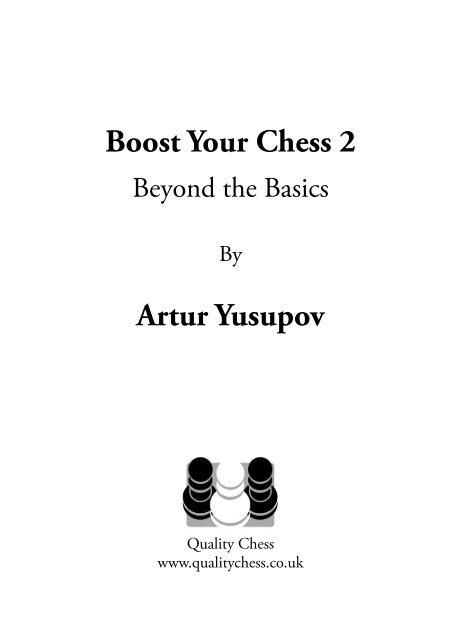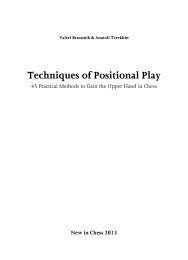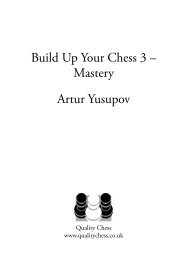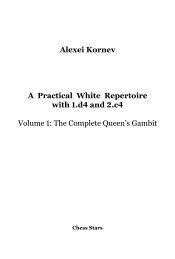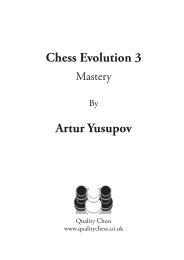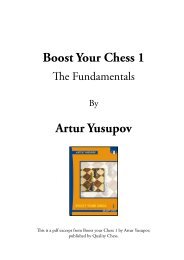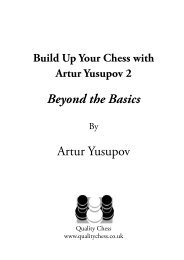Boost Your Chess 2 Artur Yusupov - Quality Chess
Boost Your Chess 2 Artur Yusupov - Quality Chess
Boost Your Chess 2 Artur Yusupov - Quality Chess
You also want an ePaper? Increase the reach of your titles
YUMPU automatically turns print PDFs into web optimized ePapers that Google loves.
<strong>Boost</strong> <strong>Your</strong> <strong>Chess</strong> 2<br />
Beyond the Basics<br />
By<br />
<strong>Artur</strong> <strong>Yusupov</strong><br />
<strong>Quality</strong> <strong>Chess</strong><br />
www.qualitychess.co.uk
CONTENTS<br />
Key to symbols used 4<br />
Preface 5<br />
Introduction 6<br />
1 Attacking the king 8<br />
2 The open file 18<br />
3 ‘Minor’ tactics 32<br />
4 Opening repertoire for White – the French Defence 42<br />
5 Simple rook endings 54<br />
6 Fighting against the pawn centre 64<br />
7 Trapping pieces 74<br />
8 Calculating short variations 82<br />
9 Weak points 92<br />
10 Line blocking 102<br />
11 Opening repertoire for Black against 1.d4 110<br />
12 Simple rook endings 2 122<br />
13 Blocking combinations 134<br />
14 The bishop pair 142<br />
15 Typical mistakes in calculating variations 156<br />
16 Removing the defence 166<br />
17 Good and bad bishops 176<br />
18 Closed openings 190<br />
19 Line clearing 202<br />
20 Endgame technique 212<br />
21 Blockade 224<br />
22 Dragging the king out 236<br />
23 Reti/English Opening 246<br />
24 Typical mistakes in the endgame 258<br />
Final test 268<br />
Index of composers 277<br />
Index of games 278
Preface<br />
It was a pleasure to have <strong>Artur</strong> <strong>Yusupov</strong> working as my second, both personally and professionally.<br />
It is therefore an honour for me to write the preface to the new manual <strong>Boost</strong> <strong>Your</strong> <strong>Chess</strong>.<br />
This new book was created by expanding and improving the original online lessons from the<br />
<strong>Chess</strong> Tigers University. As an honorary member of the <strong>Chess</strong> Tigers, it has given me great<br />
pleasure to see this logical follow-up take concrete form and meet the twin challenges of being<br />
both a valuable textbook and a bedside book.<br />
It was in 1994 that I met <strong>Artur</strong> <strong>Yusupov</strong> in the semi-finals of the Candidates’ cycle in Wijk<br />
aan Zee. I managed to come out ahead by 4.5–2.5, but I recognized that <strong>Artur</strong> harboured great<br />
potential, both in his chess knowledge and extensive match experience.<br />
<strong>Artur</strong>’s systematic and professional approach to analysing games was the decisive factor in<br />
having him as my second in the World Championship Finals in New York 1995 and Lausanne<br />
1998. His mastery of the methods of the Russian chess school was very helpful in the preparation<br />
for the matches, as well as during the matches themselves. It was his idea that I should play the<br />
Trompovsky in the last game in Lausanne. I was 3-2 down, but was able to level the match at<br />
3–3 and thus force a play-off.<br />
I am still very grateful for everything that <strong>Artur</strong> did for me.<br />
<strong>Artur</strong>’s vast experience as a trainer convinced him that there is a considerable need for better<br />
tuition for amateurs. Matching the level to the needs of the student is perhaps not too difficult,<br />
but the masterstroke is structuring the information in such a way that makes it immediately<br />
useful for amateurs. I am naturally enthusiastic about the rich variety of material in this series,<br />
which can help beginners become top amateurs.<br />
I wish <strong>Artur</strong> <strong>Yusupov</strong> all the best with the publication of the first book in the series <strong>Boost</strong> <strong>Your</strong><br />
<strong>Chess</strong>. Making this work available in English means that even more people who are keen to learn<br />
can enjoy it to the full.<br />
World Champion, Viswanathan Anand
chapter 1<br />
Contents<br />
ü Significance of the attack<br />
on the king<br />
ü Preconditions for a<br />
successful attack on the king<br />
ü Removing a defender<br />
ü Exploiting the open<br />
king position<br />
ü Sacrifices<br />
ü Forced moves<br />
Attacking the king<br />
The attack on the king has the highest priority of all<br />
in chess. For a successful attack on the king, you can<br />
sacrifice almost the whole army. But attacks do not<br />
always work. Before Steinitz, many players believed<br />
that it was only the player’s tactical abilities that had<br />
any part to play. Steinitz established that a successful<br />
attack can only be mounted if based on positional<br />
advantages – such as the initiative, better development,<br />
control over important central squares, etc.<br />
But whoever has the chance to attack must do so<br />
in the most energetic manner!<br />
In the following examples, look for the most<br />
active continuation! Bring your pieces closer to<br />
the opposing king, open up the position for your<br />
rooks and bishops, break up your opponent’s<br />
castled position, create specific threats!<br />
But you must also remain realistic: sometimes our<br />
attack on the king is ‘only enough to win material’!<br />
W.Steinitz – C.von Bardeleben<br />
Hastings 1895<br />
Diagram 1-1<br />
r<br />
1222222223<br />
Çt+ Wl+ T5<br />
ÆOoO +oOo5<br />
Å +m+v+ +5<br />
Ä+ +m+ + 5<br />
à VbP + +5<br />
Â+ N +n+ 5<br />
ÁpP + PpP5<br />
ÀR Bq+rK 5<br />
7ÈÉÊËÌÍÎÏ9<br />
8<br />
1.e4 e5 2.¤f3 ¤c6 3.¥c4 ¥c5 4.c3 ¤f6 5.d4 exd4<br />
6.cxd4 ¥b4† 7.¤c3!<br />
An old gambit line. 7.¥d2 is the safer way.<br />
7...d5!<br />
A better option is 7...¤xe4 8.0–0 ¥xc3, as in the<br />
game Steinitz – Schlechter in the same tournament.<br />
8.exd5 ¤xd5 9.0–0 ¥e6<br />
Diagram 1-1<br />
It is risky for Black to take the pawn as White’s lead<br />
in development would be too great. After 9...¤xc3<br />
10.bxc3 ¥xc3 comes 11.¥xf7† ¢f8 12.£b3! ¥xa1<br />
13.¥a3† ¤e7 14.¦e1+–; while if 9...¥xc3 10.bxc3<br />
¤xc3, then 11.£b3 gives White a strong attack.<br />
10.¥g5!<br />
White brings his bishop into the game with tempo,<br />
thus increasing his lead in development.<br />
10...¥e7!<br />
For his part, Black loses a tempo. However, it is very<br />
difficult to correctly evaluate the attack which ensues.<br />
8
Attacking the king<br />
Kasparov gives the better defence: 10...£d7<br />
11.¥xd5 ¥xd5 12.¦e1† ¢f8²<br />
11.¥xd5! ¥xd5 12.¤xd5<br />
12.¥xe7 is not so good, because after 12...¤xe7<br />
13.¦e1 0–0 14.¦xe7 Black has the intermediate<br />
move 14...¥xf3!=.<br />
12...£xd5 13.¥xe7 ¤xe7<br />
Diagram 1-2<br />
14.¦e1<br />
A typical idea to prevent the opponent castling.<br />
14...f6 15.£e2<br />
Later Zaitsev suggested another, even better, way to<br />
pursue the attack with 15.£a4†! and now:<br />
a) Perhaps Black should surrender a pawn: 15...£d7<br />
16.£b4 ¢f7 (16...c6 17.¦xe7†+–) 17.£xb7 ¤d5±<br />
b) 15...¢f7 16.¤e5†! fxe5 17.¦xe5 £d6 18.£c4†<br />
¢f8 19.¦ae1 ¤g8 (19...¤g6 20.¦f5†+–) 20.¦d5<br />
£c6 21.£b4† ¢f7 22.¦c5 £d6 23.£c4† ¢f8<br />
24.¦xc7+– (Geller)<br />
15...£d7<br />
15...£d6 would be bad: 16.£b5† £c6 17.£b4<br />
£d6 18.£xb7+–<br />
16.¦ac1<br />
Steinitz brings his final reserves into the game; it<br />
can be very useful to attack with all available forces!<br />
16.¦ad1! (Zaitsev) would also be very strong.<br />
16...c6<br />
The immediate 16...¢f7! is correct, in order to bring<br />
the knight to d5 more rapidly, e.g. 17.£c4† ¤d5 is<br />
fine for Black. The exchange sacrifice 17.£xe7†! is<br />
not dangerous: 17...£xe7 18.¦xe7† ¢xe7 19.¦xc7†<br />
¢d6 20.¦xg7 ¦ac8 21.g3 ¦c7! (Kasparov)<br />
Steinitz developed the principle: ‘The player with<br />
the advantage must attack!’ White has brought<br />
all his pieces into the game. If he now hesitates, his<br />
opponent will also bring his reserves into play and the<br />
initiative will disappear. So Steinitz sacrifices a pawn,<br />
opens files and puts his opponent under pressure.<br />
Diagram 1-3<br />
17.d5!! cxd5<br />
17...¢f7 is objectively better: 18.dxc6 bxc6±<br />
(Kasparov)<br />
18.¤d4<br />
This superb square is only a staging-post for<br />
the knight, who is aiming to get even closer to the<br />
9<br />
Diagram 1-2<br />
<br />
r<br />
1222222223<br />
Çt+ +l+ T5<br />
ÆOoO MoOo5<br />
Å + + + +5<br />
Ä+ +w+ + 5<br />
à + P + +5<br />
Â+ + +n+ 5<br />
ÁpP + PpP5<br />
ÀR +q+rK 5<br />
7ÈÉÊËÌÍÎÏ9<br />
Diagram 1-3<br />
r<br />
1222222223<br />
Çt+ +l+ T5<br />
ÆOo+wM Oo5<br />
Å +o+ O +5<br />
Ä+ + + + 5<br />
à + P + +5<br />
Â+ + +n+ 5<br />
ÁpP +qPpP5<br />
À+ R R K 5<br />
7ÈÉÊËÌÍÎÏ9<br />
chapter 1
chapter 1<br />
<br />
Diagram 1-4<br />
r<br />
1222222223<br />
Çt+t+ + +5<br />
ÆOo+wMlOo5<br />
Å + +nO +5<br />
Ä+ +o+ + 5<br />
à + + + +5<br />
Â+ + + + 5<br />
ÁpP +qPpP5<br />
À+ R R K 5<br />
7ÈÉÊËÌÍÎÏ9<br />
Diagram 1-5<br />
r<br />
1222222223<br />
Çt+t+l+ +5<br />
ÆOo+wM +o5<br />
Å + + Oo+5<br />
Ä+ +o+ N 5<br />
à + + +q+5<br />
Â+ + + + 5<br />
ÁpP + PpP5<br />
À+ R R K 5<br />
7ÈÉÊËÌÍÎÏ9<br />
Diagram 1-6<br />
r<br />
1222222223<br />
Ç V +t+ +5<br />
Æ+o+wTl+o5<br />
Åo+ +rOo+5<br />
Ä+ +p+ + 5<br />
Ãp+ + N +5<br />
Â+q+ + Pp5<br />
Á + + P +5<br />
À+r+ + K 5<br />
7ÈÉÊËÌÍÎÏ9<br />
Tactics 1<br />
opposing king!<br />
18...¢f7 19.¤e6<br />
The threat is now 20.¦c7.<br />
19...¦hc8<br />
19...¦ac8 is likewise met by 20.£g4.<br />
Nor is 19...¤c6 any better; White wins with<br />
20.¤c5 £c8 21.£h5† (Kasparov).<br />
Diagram 1-4<br />
20.£g4!<br />
The attacking side cannot afford to waste time! The<br />
threat is mate in two moves.<br />
20...g6 21.¤g5† ¢e8<br />
Diagram 1-5<br />
Steinitz now ends the game with a fantastic<br />
combination.<br />
22.¦xe7†! ¢f8!<br />
The most stubborn reply. If 22...£xe7, then<br />
23.¦xc8† ¦xc8 24.£xc8† is a simple win.<br />
After 22...¢xe7 then 23.¦e1† wins. (23.£b4†! is<br />
also good, but you can only win a game once! The<br />
important thing is to calculate your winning line<br />
carefully.) 23...¢d6 24.£b4† ¦c5 (24...¢c6 25.¦c1#;<br />
24...¢c7 25.¤e6† ¢b8 26.£f4†+– Steinitz) 25.¦e6†<br />
£xe6 26.¤xe6+–<br />
23.¦f7†!<br />
But not 23.£xd7 ¦xc1†–+.<br />
23...¢g8!<br />
23...£xf7 24.¦xc8† ¦xc8 25.£xc8† £e8 26.¤xh7†<br />
is hopeless.<br />
24.¦g7†! ¢h8!<br />
Or 24...¢f8 25.¤xh7† ¢xg7 26.£xd7†+–.<br />
25.¦xh7†!<br />
After this move von Bardeleben simply left the<br />
tournament hall! Steinitz demonstrated the following<br />
forced variation for the benefit of the spectators:<br />
25...¢g8 26.¦g7†! ¢h8 27.£h4† ¢xg7 28.£h7†<br />
¢f8 29.£h8† ¢e7 30.£g7† ¢e8 31.£g8† ¢e7<br />
32.£f7† ¢d8 33.£f8† £e8 34.¤f7† ¢d7 35.£d6#<br />
10<br />
Diagram 1-6<br />
J.Capablanca – N.Zubarev<br />
Moscow 1925<br />
Capablanca finds an elegant and forcing way to win.<br />
1.¦xe7† ¢xe7
Attacking the king<br />
Otherwise White wins with the discovered check<br />
d5-d6.<br />
2.£xb7 ¥xf4 3.¦e1†!<br />
An important intermediate check, which leads to<br />
the following forced line.<br />
3...¥e5<br />
3...¢d6 loses to 4.£b6†, as does 3...¢d8 to<br />
4.£a8†.<br />
4.d6†! ¢e6<br />
4...¢d8 is met by 5.£b6†+–.<br />
5.£b3† ¢f5<br />
5...¢xd6 loses the queen after 6.¦d1†.<br />
6.£d3† ¢g5 7.£e3† ¢f5<br />
If 7...¢h5, then 8.g4†+–.<br />
8.£e4† ¢e6<br />
8...¢g5 9.£h4† ¢f5 10.£g4#<br />
9.£c4† ¢xd6<br />
Forced, since 9...¢f5 runs into 10.£g4#.<br />
10.¦d1† ¢e7 11.¦xd7† ¢xd7 12.£xa6<br />
The attack has secured White a decisive material<br />
advantage.<br />
1–0<br />
Diagram 1-7<br />
J.Capablanca – H.Steiner<br />
Los Angeles 1933<br />
1.f4!<br />
The black king is already rather exposed. White<br />
opens further lines for the attack.<br />
1...¦g8 2.£h5† ¢g7 3.fxe5 dxe5<br />
Diagram 1-8<br />
4.¦xf6!<br />
A very natural continuation of the attack. White<br />
loses no time getting on with the decisive onslaught.<br />
4...¢xf6 5.¦f1† ¤f5<br />
5...¢g7 6.¦f7† ¢h8 7.£xh7#<br />
6.¤xf5!<br />
Here Capablanca had certainly calculated all the<br />
way to the end.<br />
6...exf5 7.¦xf5† ¢e7 8.£f7† ¢d6 9.¦f6† ¢c5<br />
10.£xb7!<br />
A difficult move, but one which contains several<br />
mating threats.<br />
10...£b6<br />
11<br />
Diagram 1-7<br />
<br />
r<br />
1222222223<br />
Çt+ W T +5<br />
ÆOo+ Ml+o5<br />
Å +oOoO +5<br />
Ä+ + O + 5<br />
à + +p+qN5<br />
Â+ Pp+ + 5<br />
Áp+p+ PpP5<br />
ÀR + +rK 5<br />
7ÈÉÊËÌÍÎÏ9<br />
Diagram 1-8<br />
r<br />
1222222223<br />
Çt+ W +t+5<br />
ÆOo+ M Lo5<br />
Å +o+oO +5<br />
Ä+ + O +q5<br />
à + +p+ N5<br />
Â+ Pp+ + 5<br />
Áp+p+ +pP5<br />
ÀR + +rK 5<br />
7ÈÉÊËÌÍÎÏ9<br />
chapter 1
chapter 1<br />
<br />
Diagram 1-9<br />
r<br />
1222222223<br />
Çt+ +tL +5<br />
Æ+w+ +oO 5<br />
Å + O V O5<br />
Ä+ +pOp+q5<br />
ÃoOpM +r+5<br />
Â+p+b+ + 5<br />
Áp+ B +pP5<br />
À+ + +r+k5<br />
7ÈÉÊËÌÍÎÏ9<br />
Tactics 1<br />
Or 10...£xf6 11.£b4#.<br />
11.¦xc6†! £xc6<br />
11...¢b5† 12.¦xb6† axb6 13.£xh7+– would lead<br />
to a prospectless ending.<br />
12.£b4#<br />
Diagram 1-9<br />
E.Vasiukov – M.Taimanov<br />
USSR Ch, Kharkov 1967<br />
The black king wants to escape to the centre. To<br />
prevent that happening, White must act immediately.<br />
1.¦xg7!<br />
A correct sacrifice.<br />
1...¢xg7<br />
As the following variations show, other moves are<br />
no better:<br />
a) 1...¥xg7 2.f6 ¥xf6 3.¦xf6 ¦e7 4.£xh6† ¢e8<br />
5.¦xd6 ¦d7 6.£h8† ¢e7 7.£xe5†+–<br />
b) 1...axb3 2.¥xh6 (…¦xf7†) 2...¥xg7 3.f6+–<br />
c) 1...¦e7 2.¦g4 ¢e8 3.£xh6 axb3 4.axb3 ¤xb3<br />
5.¦g8† ¢d7 6.¦xa8 £xa8 7.¥xb4+–<br />
White was faced with an interesting problem at<br />
this point in the game. Which is more important<br />
here, material (£xh6† and then £xf6) or the attack<br />
(¥xh6†)<br />
2.£xh6†<br />
White decides on material and wins the bishop.<br />
However, in doing so he loses a tempo for the attack.<br />
The correct choice is 2.¥xh6†! ¢g8 3.£g4† ¢h8<br />
4.¥g5! ¥xg5 (4...£e7 5.£h4†+–) 5.f6! ¥h6 (5...¥xf6<br />
6.¦xf6+–) 6.£h5+–.<br />
2...¢g8 3.£xf6 £e7 4.£h6 f6 5.¥xb4 axb3<br />
The position is now anything but clear, since the<br />
black rooks can become active via the open queenside.<br />
White takes an unfortunate decision and leaves the<br />
dangerous black pawn on the board.<br />
6.a3! ¦ac8 7.h3!<br />
7.¦e1!<br />
7...£g7 8.£h4 e4!<br />
Now it is Black who wants to open lines. He takes<br />
the initiative and even goes on to win the game.<br />
9.¥xe4 ¤e2! 10.¥d3 ¤g3† 11.¢g1 ¤xf1 12.¢xf1<br />
¦e3 13.¥b1 ¦ce8 14.£f4<br />
And White resigned.<br />
12
Ex. 1-1 «« r<br />
1222222223<br />
Ç + T +l+5<br />
ÆOoO + On5<br />
Å + O +qO5<br />
Ä+ + M + 5<br />
à + +nWv+5<br />
Â+ + + + 5<br />
ÁpPp+ PpP5<br />
À+ + R K 5<br />
7ÈÉÊËÌÍÎÏ9<br />
Exercises<br />
1222222223<br />
Çt+ + Tl+5<br />
Æ+vO +oOo5<br />
ÅoO +oM +5<br />
Ä+ +w+ + 5<br />
à V PnP +5<br />
Â+ +b+nP 5<br />
ÁpP +qP P5<br />
À+ Rr+ K 5<br />
7ÈÉÊËÌÍÎÏ9<br />
Ex. 1-4 « r<br />
<br />
chapter 1<br />
Ex. 1-2 « q<br />
1222222223<br />
Ç + + +tL5<br />
ÆOo+ Oo+o5<br />
Å + W +tV5<br />
Ä+ +p+v+ 5<br />
à + P P +5<br />
Â+p+ +q+p5<br />
ÁpB N R K5<br />
À+ R + + 5<br />
7ÈÉÊËÌÍÎÏ9<br />
Ex. 1-3 «« r<br />
1222222223<br />
Çt+ +tL +5<br />
ÆO +w+ Oo5<br />
Å O OrV +5<br />
Ä+ Mp+ + 5<br />
à +oQ + N5<br />
Â+ B + + 5<br />
ÁpP + P P5<br />
À+ + R K 5<br />
7ÈÉÊËÌÍÎÏ9<br />
Ex. 1-5 « r<br />
1222222223<br />
Ç T + Tl+5<br />
ÆOvWm+oO 5<br />
Å + +o+ O5<br />
Ä+ O + + 5<br />
à +p+ +m+5<br />
Â+ B Pn+ 5<br />
Áp+ +bPpP5<br />
ÀQ +r+rK 5<br />
7ÈÉÊËÌÍÎÏ9<br />
Ex. 1-6 «« r<br />
1222222223<br />
Ç +v+ Tl+5<br />
Æ+ + +o+ 5<br />
Åo+ Qo+oV5<br />
Ä+wO P +p5<br />
à + R P +5<br />
Â+ P +b+ 5<br />
Á P + + +5<br />
À+ K + R 5<br />
7ÈÉÊËÌÍÎÏ9<br />
13
chapter 1<br />
<br />
Ex. 1-7 «« r<br />
1222222223<br />
Ç + +tTl+5<br />
Æ+vO +oOo5<br />
Åo+w+ V B5<br />
Ä+oM +b+ 5<br />
à + +n+q+5<br />
Â+ P + +p5<br />
ÁpP + Pp+5<br />
À+ +rR K 5<br />
7ÈÉÊËÌÍÎÏ9<br />
Exercises<br />
Ex. 1-10 « q<br />
1222222223<br />
Ç + Tt+l+5<br />
ÆOv+ +oOo5<br />
Å O + M +5<br />
Ä+ P + W 5<br />
à + P +n+5<br />
ÂP + +o+p5<br />
ÁbB Q P +5<br />
À+ Rr+ K 5<br />
7ÈÉÊËÌÍÎÏ9<br />
Ex. 1-8 «« r<br />
1222222223<br />
Ç +lVt+ T5<br />
ÆQo+m+o+ 5<br />
Å Po+ +o+5<br />
ÄR P + +o5<br />
à + + + +5<br />
Â+nW + Pp5<br />
Áp+ + Pk+5<br />
À+ +r+ + 5<br />
7ÈÉÊËÌÍÎÏ9<br />
Ex. 1-9 « q<br />
1222222223<br />
Ç + + + +5<br />
ÆOt+ +oL 5<br />
Å + +o+o+5<br />
ÄW OmP Bt5<br />
à Oq+r+ P5<br />
Â+ +r+ + 5<br />
ÁpPp+ P +5<br />
ÀK + + + 5<br />
7ÈÉÊËÌÍÎÏ9<br />
Ex. 1-11 «« q<br />
1222222223<br />
Ç + + +tL5<br />
ÆOo+ + To5<br />
Å +o+v+ +5<br />
Ä+ +oP +w5<br />
Ãp+ P O +5<br />
Â+ P M + 5<br />
Ár+ + QpP5<br />
ÀR + NbK 5<br />
7ÈÉÊËÌÍÎÏ9<br />
Ex. 1-12 ««« q<br />
1222222223<br />
Ç + + Tl+5<br />
Æ+ O +t+ 5<br />
Å O + + V5<br />
Ä+ OpOv+ 5<br />
Ãp+p+n+w+5<br />
Â+ Nq+ Po5<br />
Á + + R P5<br />
À+ + +r+k5<br />
7ÈÉÊËÌÍÎÏ9<br />
14
Ex. 1-1<br />
Based on the correspondence game<br />
Morse – Bashein<br />
1.¤ef6†! ¢h8<br />
Of course 1...£xf6 would also be hopeless.<br />
2.¤g5!<br />
(1 point)<br />
The threat is 3.£h7#.<br />
2...£f5<br />
Or 2...¥f5 3.£e8† ¦xe8 4.¤f7† ¤xf7<br />
5.¦xe8#.<br />
3.£e8†!!<br />
Decoying.<br />
3...¦xe8 4.¤f7† ¤xf7 5.¦xe8#<br />
(another 1 point for these variations)<br />
Ex. 1-2<br />
L.Rellstab – V.Petrovs<br />
Kemeri 1937<br />
1...¥xf4†! 2.£xf4 ¦g3!<br />
(1 point)<br />
2...¦h6 is just as good, since 3.¦c3 £g6!<br />
wins for Black.<br />
White resigned, in view of 3.£xd6 ¦xh3#<br />
or 3.£xf5 ¦g2† 4.¢h1 £h2# or 3.¢h1<br />
£xf4–+.<br />
Ex. 1-3<br />
Tomas – Markwell<br />
Correspondence game<br />
1.¦xf6†!<br />
(1 point)<br />
1...gxf6 2.£xf6† £f7<br />
2...¢g8 3.£h8†+–<br />
3.¤g6†!<br />
Or 3.£h8† £g8† 4.¤g6†!+–.<br />
3...hxg6 4.£h8† £g8 5.£h6†! ¢f7 6.£f4#<br />
(another 1 point)<br />
Solutions<br />
Ex. 1-4<br />
J.Capablanca – A.Becker<br />
Karlsbad 1929<br />
<br />
1.¤fg5!<br />
(1 point)<br />
White threatens ¤xf6† followed by ¥e4.<br />
The immediate 1.¤xf6† only leads to a<br />
draw: 1...gxf6 2.¦xc7 £xf3 3.¦xb7! £xb7<br />
4.£g4† ¢h8 5.£h4 f5 6.£f6†=<br />
1...¤e8<br />
No better are 1...£xd4 2.¥b1+– or 1...¤xe4<br />
2.¥xe4+–.<br />
2.¤xh7! f5 3.¤hg5!<br />
3.¤xf8 also wins after 3...¢xf8 4.f3.<br />
Black resigned, as 3...fxe4 is simply met by<br />
4.¥xe4+–.<br />
Other moves also lose, e.g. 3...¤f6 4.¥c4<br />
£d8 5.¥xe6†+– or 3...£d7 4.£h5 ¤f6<br />
5.¤xf6† gxf6 6.£g6† ¢h8 7.¤xe6 £xe6<br />
8.¦xc7 ¥e7 9.¥c4+–.<br />
Ex. 1-5<br />
J.Capablanca – E.Colle<br />
Hastings 1930/1<br />
1.¦xd7!<br />
(1 point)<br />
1.¥xg7 would be bad, due to 1...¥xf3 2.g3<br />
¥xe2–+.<br />
1...£xd7 2.¥xg7 £c7<br />
2...¦fc8 3.¤e5 ¤xe5 4.£xe5 f5 5.¥xh6±<br />
3.¥xf8 ¦xf8 4.g3±<br />
Ex. 1-6<br />
Kofman – S.Zhukhovitsky<br />
Moscow 1936<br />
1.hxg6!<br />
Not the only way, but the quickest route to<br />
victory.<br />
1...cxd4 2.gxf7† ¢h8<br />
2...¢xf7 3.¥h5#<br />
2...¢h7 3.¥e4† ¢h8 4.£xf8† ¥xf8 5.¦g8#<br />
chapter 1<br />
15
chapter 1<br />
<br />
3.£xf8†!<br />
(1 point)<br />
3...¥xf8 4.¦g8† ¢h7 5.¥e4† ¢h6 6.¦h8†<br />
¢g7 7.¦h7#<br />
(another 1 point)<br />
Ex. 1-7<br />
E.Vasiukov – R.Kholmov<br />
Moscow 1964<br />
1.¤xc5!<br />
(1 point)<br />
1.¥xg7 ¥xg7 2.¤xc5 (1 consolation point)<br />
is less precise, on account of 2...¦xe1† 3.¦xe1<br />
h6 4.¤xb7 £xb7±.<br />
1...£xc5 2.¥xg7!<br />
Black resigned, in view of 2...¥xg7 3.£h5<br />
¦xe1† 4.¦xe1 h6 5.¥h7†+–.<br />
(another 1 point for finding this idea)<br />
Ex. 1-8<br />
Mumelter – N.N.<br />
Vienna 1896<br />
1.£a8†!<br />
(1 point)<br />
1.¦xd7 also wins, but is more complicated:<br />
1...¢xd7 2.£xb7† ¢e6 3.£xc6† (1 consolation<br />
point) 3...¢f5 4.£d6 ¦e5 (4...¥f6 5.c6†<br />
¦e5 6.¤d4† ¢e4 7.f3† ¢d3 8.¤b5†+–)<br />
5.¤d4† ¢e4 6.¦a4+–<br />
1...¤b8 2.¦xd8†! ¦xd8<br />
Or 2...¢xd8 3.£xb8† ¢d7 4.£d6† ¢c8<br />
5.¦a8#.<br />
3.£xb7†! ¢xb7 4.¦a7† ¢c8 5.¦c7#<br />
(another 1 point for the whole variation)<br />
Ex. 1-9<br />
A.Suetin – G.Kasparian<br />
USSR Ch, Moscow 1952<br />
The game saw 1...¤b6 2.¥f6† and Black<br />
resigned, because 3.¦d8 is coming next.<br />
The correct continuation would have been:<br />
Solutions<br />
1...¦xg5! 2.hxg5 ¤b6 3.£b3 c4 4.¦xc4<br />
¤xc4 5.£xc4 b3 6.cxb3 £e1†–+<br />
(1 point)<br />
Ex. 1-10<br />
Variation from the game<br />
S.Bromberger – S.Löffler<br />
Bundesliga 2002<br />
1...¦e1†!!<br />
By this deflection, Black gains the time<br />
needed for the capture on g4.<br />
2.£xe1 ¤xg4 3.¢h1<br />
3.¥xf7† ¢xf7–+<br />
3...£h4 4.£f1 ¤xf2† 5.¢h2 £f4† 6.¢g1<br />
£g3†–+<br />
(1 point)<br />
Ex. 1-11<br />
G.Stahlberg – A.Alekhine<br />
Prague Olympiad 1931<br />
1...¤g4!<br />
(1 point)<br />
2.£xf4 ¦f7<br />
White resigned, on account of 3.£g3 ¤xh2<br />
(or 3...¦xf1† 4.¢xf1 ¤xh2†–+) 4.£xh2<br />
¦xf1†–+.<br />
(another 1 point for this variation)<br />
Ex. 1-12<br />
Trubnikov – Radchenko<br />
Novosibirsk 1965<br />
1...¥d2!<br />
(1 point)<br />
The defending white pieces are overloaded.<br />
This deflecting sacrifice ruins the coordination<br />
of the opposing pieces.<br />
Of course 1...¥xe4† would be bad: 2.£xe4<br />
£xe4† 3.¤xe4 ¦xf2 4.¦xf2 ¦xf2 5.¤xf2±<br />
2.£xd2<br />
If 2.¦xf5 ¦xf5 3.¤xd2, then 3...¦xf1†<br />
4.¤xf1 e4 5.¤xe4 £xe4†–+.<br />
16
2.¦xd2 is simply met by 2...¥xe4† 3.¤xe4<br />
¦xf1†–+.<br />
2...¥xe4† 3.¢g1<br />
Or 3.¤xe4 £xe4† (3...¦xf2 is also good:<br />
4.¦xf2 £xe4† 5.¢g1 £b1†–+) 4.¢g1 £g2†!<br />
5.¦xg2 ¦xf1#.<br />
(1 point for this variation)<br />
3...£xg3†! 4.hxg3 h2†! 5.¢xh2 ¦h7†–+<br />
(another 1 point for this variation)<br />
Solutions<br />
<br />
chapter 1<br />
Scoring<br />
Maximum number of points is 20<br />
18 points and above Excellent<br />
14 points and above Good<br />
10 points Pass mark<br />
If you scored less than 10 points, we recommend that you read the<br />
chapter again and repeat the exercises which you got wrong.<br />
17


